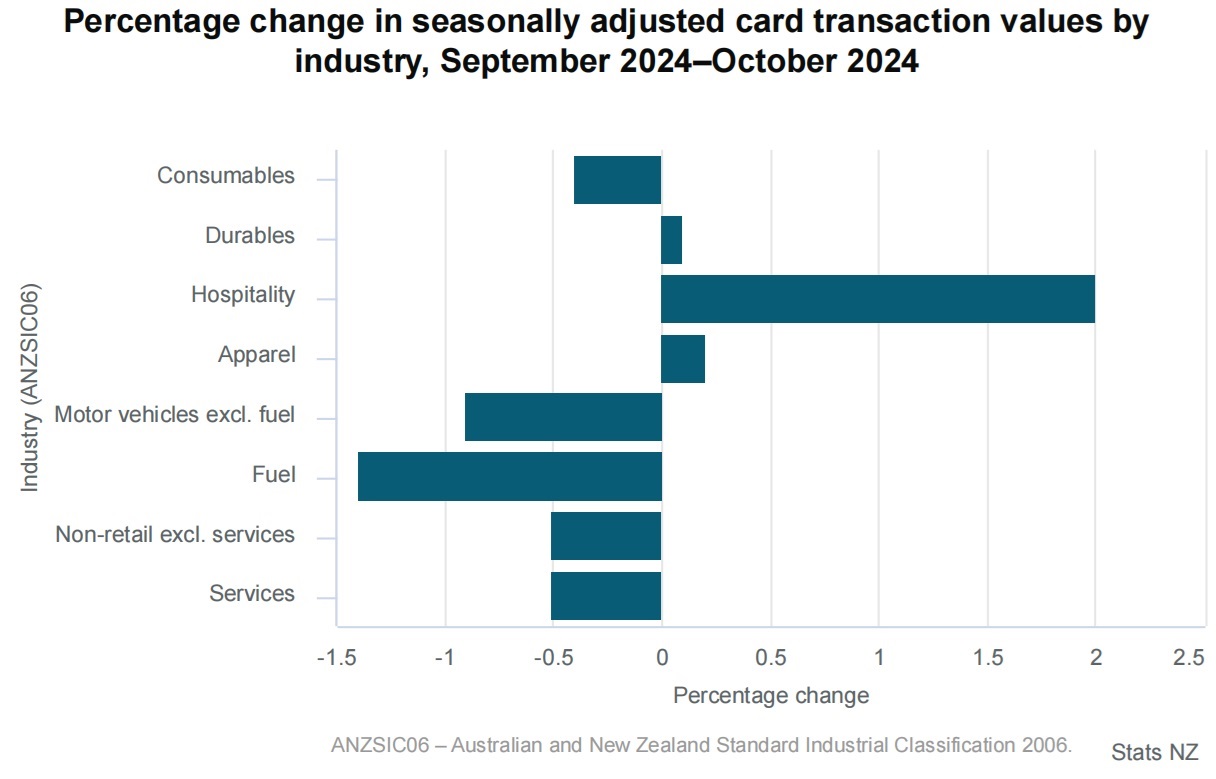
Retail spending turned up quite decisively last month after months in the doldrums, led by the hospitality industry's biggest monthly sales rise since November 2023 .
Statistics New Zealand says total retail spending rose 0.6% on a seasonally-adjusted basis in October.
Likewise, core retail spending - which doesn't include fuel and vehicles - was also up 0.6%.
The monthly rises in both core retail and total retail spending were the largest recorded since January 2024.
The latest month's rise comes after a sequence in which we saw six consecutive months of falls, followed by a very slight rise (0.2%) in August and then a flat result in September.
The big thing that's happened since August is that the Reserve Bank has begun cutting interest rates, having reduced the OCR twice, taking it down from 5.5% to 4.75%.
"New Zealand’s retail sector is starting to show signs of a turnaround," Westpac senior economist Satish Ranchhod said.
And he said the full impact of interest rate cuts is yet to be felt. Most mortgages have not come up for refixing yet. In addition, further cuts from the RBNZ are expected over the coming months.
"As those reductions pass through to households, we expect that spending levels will continue to rise."
Retail NZ Chief Executive Carolyn Young says the retail sector is continuing to face challenges, and cites their recent survey which found that 70% of survey respondents did not meet their sales targets in the July-September quarter.
"The next few weeks are critical for retailers with key sales periods including the Black Friday sales and Christmas promotions. Many retailers rely heavily on strong sales during this period to ensure they have a buffer for quieter months, so we hope that consumers will respond to improving economic conditions with increased confidence," Young said.
Previously, the wallets had been put away. The October spending figures show at least some confidence is returning, and it is noticeable that the hospitality industry was one that saw a sharp rise in the month after really struggling this year.
While we generally focus on the seasonally adjusted figures, it's always well worth comparing where the actual figures from the latest month compare with those from the same month a year ago.
As far as the core retail figures are concerned, they were up 0.5% compared with a year ago, which is the first such rise since February. The total retail figures were down 1.1% compared with October 2023 - but that's actually the lowest year-on-year monthly fall since a rise in February.
Back on the seasonally adjusted figures, here are some of the key data from October 2024:
- hospitality, up $24 million (2.0%)
- durables, up $1.2 million (0.1%)
- apparel, up $0.8 million (0.2%)
- motor vehicles (excluding fuel), down $1.8 million (0.9%)
- fuel, down $7.0 million (1.4%)
- consumables, down $11 million (0.4%).

Stats NZ said the non-retail (excluding services) category decreased by $12 million (0.5%) from September 2024. This category includes medical and other health care, travel and tour arrangement, postal and courier delivery, and other non-retail industries.
The services category was down $1.7 million (0.5%). This category includes repair and maintenance, and personal care, funeral, and other personal services.
The total value of electronic card spending, including the two non-retail categories (services and other non-retail), increased from September 2024, up $32 million (0.4%).
In actual terms, cardholders made 169 million transactions across all industries in October 2024, with an average value of $55 per transaction. The total amount spent using electronic cards was $9.3 billion, which was up 1.7% on the same month a year ago and is again the largest year-on-year increase since February of this year.
15 Comments
The big thing that has happened since August, I would argue, is people paying less for fuel, and some consumables. This has freed up money to spend on other stuff. Mortgage costs actually increased in aggregate between August and October.
Also worth noting that the year-on-year change in retail spending went down using the seasonally-adjusted figures (which adjust per sector and can therefore be different to the actuals).
I think the combined impact of expectations around a positive mortgage re-fix and the recent tax cut both play a role here. My personal consumer sentiment index is the busyness of the Mojo in my office - has been an observable pickup in recent months... I am Auckland based, may be a different story elsewhere
A lot of it is sentiment. There are a lot of people with loads of money that have put their wallets away because things looked bad rather than because they had to. They tend to get bored of that after while, especially when the RBNZ starts cutting and the sun comes out.
Have to agree, there's a noticeable uptick in people/entities that have money, who are now spending it.
The sky did not fall, can only sit on your hands so long.
Or this could be a dopamine bump from the first rate cut. Time will tell.
Better weather and temperatures = better sentiment XD
For me i think retailers have been hitting the ceiling of the price increases they have been able to put out in recent years, which has meant they are actually now are attempting to meet the market and offer better deals for customers. You can see this by The Warehouse having to change tack to a focus on value as are many others too.
Stihl shop specials.... not that common in the past now like briscoes
Q. Does hospitality include short-term accommodation? Because what effect does the first positive travel (net +50,000 people in October AirPAX) have. In fact, is this spending per-capita or overall - because there are approx. 1% more people in the country at the end of the month vs the start?
The headline made me chuckle ... "hospitality industry has biggest monthly rise since November 2023"
So Christmas, right?
But I thought there was gonna be a severe deep depression with sky high unemployment ?
Surely the commentators on here couldn’t be wrong about that.
Or they have different interpretations of how bad "bad" is.
That is always the excuse when they get it wrong
Weather is better!
The timing of the term 3 school holidays this year vs '23 would have had quite a significant impact on this data (2wks of school holidays falling in oct24 vs 1wk in oct23).

We welcome your comments below. If you are not already registered, please register to comment.
Remember we welcome robust, respectful and insightful debate. We don't welcome abusive or defamatory comments and will de-register those repeatedly making such comments. Our current comment policy is here.